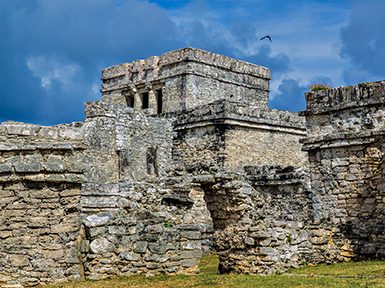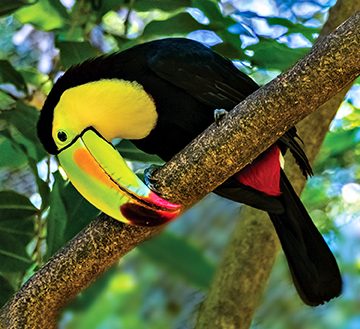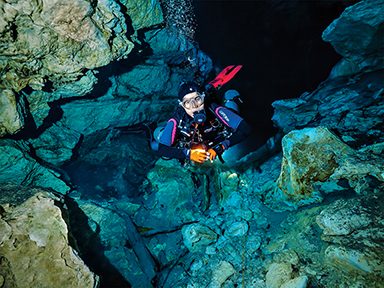SOME OF THE WORLD’S MOST BEAUTIFUL FLOODED CAVES are underneath the jungle of Mexico’s Yucatán Peninsula. The peninsula began as a coral reef, which sea-level fluctuations during various ice ages exposed to the atmosphere. Acidic rainfall traveled through the porous limestone, dissolving the rocks and forming solution caves. This process created stalagmites, stalactites, and columns. After the ice ages, these caves filled with water, preventing these formations from changing and freezing them in time.
Some of the cave ceilings collapsed, forming cenotes. These flooded sinkholes have always been important to the area. The cenotes are essential sources of fresh water, and the Mayans, considering them sacred, built near them and used some as places for sacrifice. Archaeologists have found artifacts, including jewels, pots, clothes, sculptures, and human and animal bones.
Today the Yucatán Peninsula has become a significant tourist destination known as the Mayan Riviera. Visitors from all over the world come to enjoy Mexico’s Caribbean beaches and swim in the cenotes. Sea turtles use many of the beaches for nesting. The Yucatán jungle is home to jaguars, monkeys, wild boars, deer, and many bird species. Unfortunately, as the region develops, this habitat disappears, endangering much of the wildlife. The Mexican agouti, for example, is a species of rodent that is common in the area but is critically endangered.
Marine life in the cenotes is limited, but it is possible to encounter catfish, mollies, and tetras. These fish inhabit the open-water areas. Visitors to the caves can also see fish without eyes, an adaptation to living in total darkness, and may occasionally spot a crocodile — the limestone ledges and mangrove bushes around cenote openings are the perfect habitats for these animals.
For many years before the rest of the world discovered the area, cave divers from all over traveled to the Yucatán to explore this natural wonderland. Cave diving requires special technical training, and cave divers are a special breed. Buoyancy, trim, and equipment configuration are critical to diving safely in a cave. Some rules that cave divers must follow include always having three lights and a continuous guideline to open water and managing their breathing gas in thirds: one-third for entry, one-third for exit, and one-third for emergencies.
Besides safety, cave diving training focuses on preserving delicate natural cave decorations we can never recover once we destroy them. The training is very technical and is like going to diving graduate school. All the efforts to become a cave diver will make you a better diver in open water and allow you to experience these untouched wonders of the natural world.
Unfortunately, progress and development could now destroy the caves in the Yucatán.
Many trains were built across the country during the late 1800s and early 1900s. It was a popular and burgeoning travel method until the latter half of the 20th century, when it began to decline due to competition from other options. Now there is a push to bring back train travel. These trains will help locals commute to work and bring tourists to new communities. The hope is that more people taking trains instead of driving cars will reduce air pollution.
One of the projects is the Tren Maya. This nearly $10 billion project will run 932 miles in a large loop between Cancun and Palenque, Chiapas. The train will transport passengers and freight into the Yucatán Peninsula. It is supposed to enable tourism in remote areas and create many new jobs, spurring economic growth in the region.
At first glance, the Tren Maya sounds like a good idea, but there are problems. Many locals are concerned that young people will abandon their villages and move close to a town with a train stop for employment. This shift could depopulate some areas while causing overpopulation in others.
The original route, along the only southward road on the peninsula, was changed to run the train directly through Dos Ojos Park, taking it over a thin layer of limestone above the area’s fragile cave systems. It will pass within 1,000 feet of a cenote dive site called Dreamgate and could cause Sac Actún, one of the world’s largest flooded caverns, to collapse. This construction could cause permanent damage to the environment, Mayan villages, archaeological sites, and the caves we love to explore. In addition, building and operating the Tren Maya is expected to cause pollution runoff that will affect the coral reefs off the coast. Mexico’s National Council on Science and Technology reported in 2019 that the train line would threaten a minimum of 10 protected natural areas, 1,300 archaeological sites, and more than 143,000 indigenous Mayans living in the area.
The train project is scheduled to be completed by the end of 2023. Besides the environmental damage, many experts question if a high-speed train built over limestone is safe. It is possible that the geology cannot support the weight of a train. This danger could cause the project to fail after the irreversible environmental damage is done.
Many locals believe that a well-planned train project would benefit the area, but the Tren Maya project has enough problems that it might do more harm than good. The best alternative appears to be moving the rail route back to its original path along the existing highway. Peter Sprouse from the Association for Mexican Cave Studies says that moving the train route 7 to 8 miles away from the coast will minimize how many caves collapse, as most of the area’s cave systems are 6 miles from the ocean. The area near the highway is already developed, but even so, the Tren Maya project will still cause environmental damage.
Divers, scientists, archaeologists, and activists urge the Mexican government to slow the project and spend more time considering all the environmental concerns. If you would like to lend your support, a petition is available at https://bit.ly/3uN3ex4. I invite divers and anyone concerned with environmental preservation to sign it, and let’s hope the petition doesn’t fall on deaf ears.



Unfortunately, progress and development could now destroy the caves in the Yucatán.